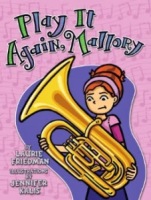We all know those authors–the ones who’ve written SO MANY BOOKS. Ever wonder how they keep their characters straight? Or how they managed to capture the voice of a nine-year-old in one book while also nailing the perspective of a thirteen-year-old in another book? Or how they can churn out twenty-some installments of a series, in which the main character grows and changes without losing her core personality? Yeah, “those authors”–the ones who are as versatile as they are prolific. Mysterious, aren’t they? Here’s Laurie Friedman to share some tricks of the series-writing trade.
 |
This is Laurie Friedman
talking to you now. |
For as long as I can remember, I have been a series reader. As a young girl, I would curl up in my favorite chair (still in my office today) and while away the hours with stacks of Nancy Drew, Ramona, and Encyclopedia Brown books by my side. As my own kids grew, we read through Harry Potter, Twilight, Lemony Snicket, and The Hunger Games together, and I enjoyed every minute of it. Give me a character I love, and I’ve never been able to resist coming back for more. So it’s no surprise that as an author, I gravitated toward writing series. I’m proud to say that I’ve written series picture books (Ruby Valentine), chapter books (Mallory) and a new series for teens, The Mostly Miserable Life of April Sinclair. Over the years, people have asked how I keep my characters straight and the voices distinctive and fresh for each age group. For me, that’s where the art and science of series writing come in.
 |
It’s not all fun and games!
Series writing is serious business. |
Whenever I start a new book in a series, the first thing I do is a rough story outline. Once that’s done, I do the math. For a person who thinks more creatively than analytically, that’s always a challenge, but there’s a structural component of successful series that cannot be ignored. One of the reasons readers return to series they love is that they know what kind of reading experience to expect when they pick up the latest installment. As a series writer, I think it’s critical to think through issues like word count, chapter length, and plot structure on the front end. Once my “blueprint” is in place, the art of the creative process–creating voice, characters, and situations that ring true for each age group–can begin.
 |
| “What’s my blueprint? Hmm.” |
I go about this in a couple of different ways. As a girl, I was a meticulous journal keeper. Fortunately, my mother saved the stacks of notebooks I filled with the daily goings-on of my young life. Referring back to what I did or felt at a particular age helps me write characters that feel true to their ages. I also spend a lot of time talking to kids who are the age of the character I’m writing about. When I start a new book, I always go to classrooms and talk to students about the plot and characters I’m creating. Their facial expressions are a visual thumbs up or down on a plot. It’s the best gauge I know to keep it real and fresh, and that’s how I’ve ensured that my characters for different audiences have stayed distinctive.
 |
Each character should say
“catastrophe” in her own voice. |
But is there a point where they all intersect? The answer to that is a resounding YES! At the heart of all my characters are flaws, hopefully lovable flaws. Perfect people who always make the right decisions don’t exist in life (and if they do, no one likes them anyway) and shouldn’t in books either. My greatest hope as an author is that my books are entertaining. I want kids to like reading them, but if they also find a place to connect with a character because that character feels real and authentic and familiarly flawed, then I feel as if I’ve done my job.
Like this:
Like Loading...
Related



